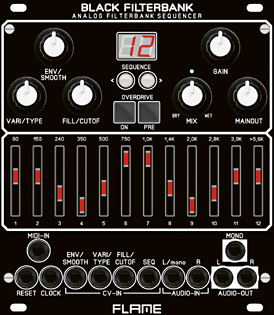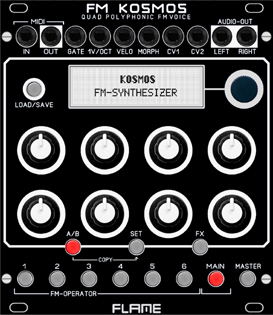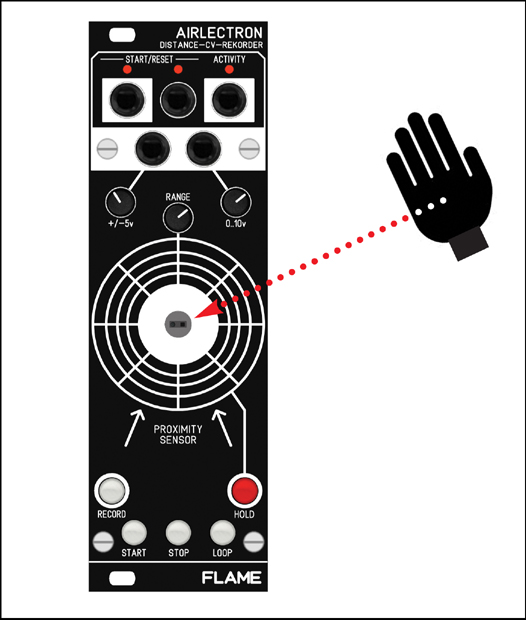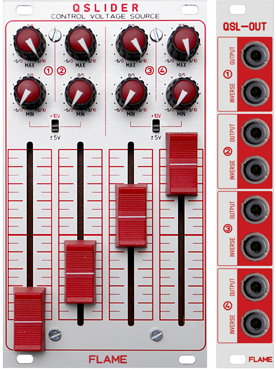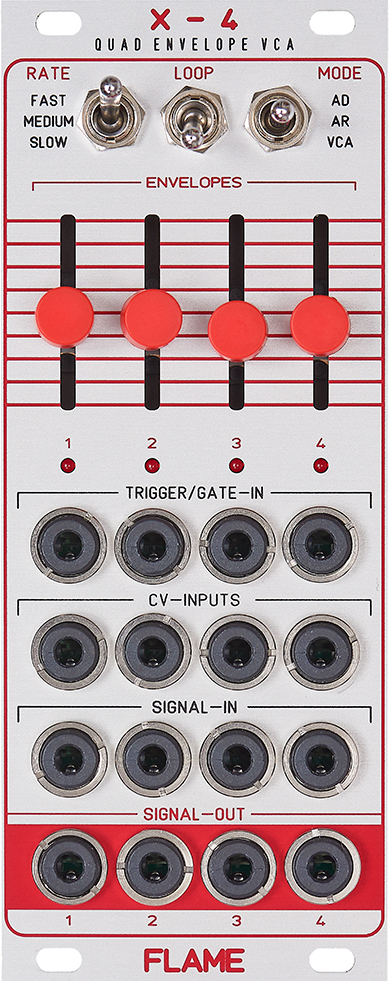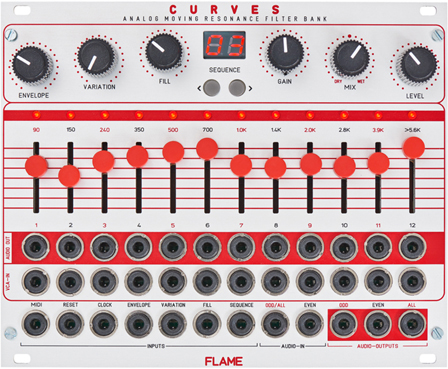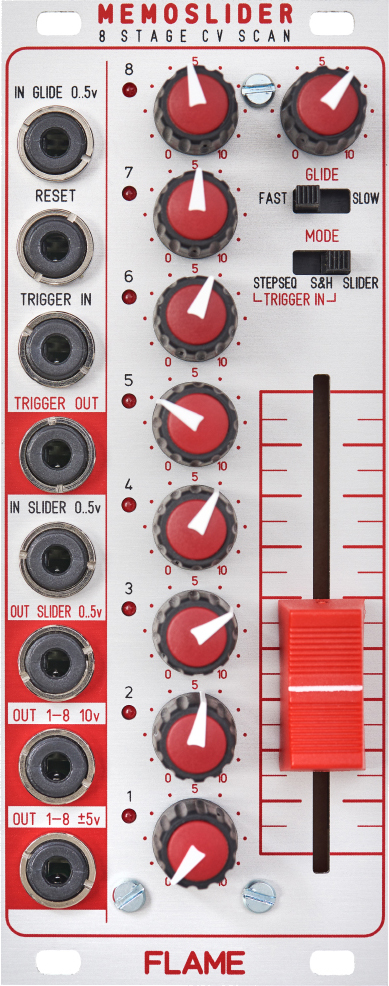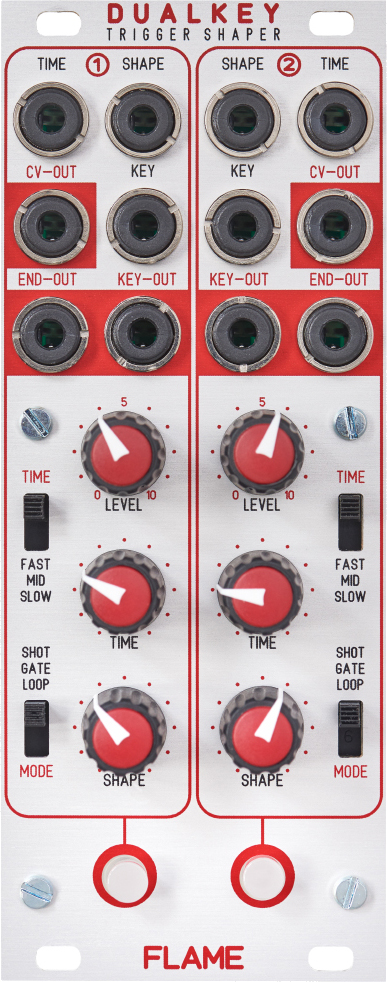
 |
  
For older devices/modules click here! |
|
FLAME "FIRE"
8 voice percussion synthesizer
|
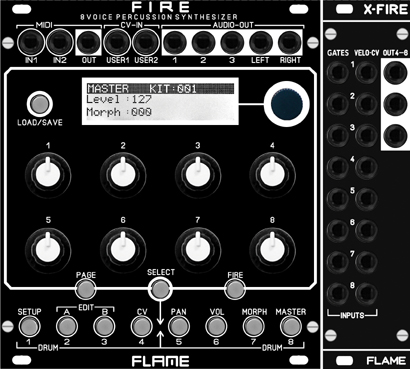 |
The module is a full 8-way polyphonic drum and percussion synthesizer. It offers different digital synthesis algorithms, which can be distributed over 8 channels. The sound engine delivers virtual analog sounds as well as different digital percussion sounds, which are generated with FM or virtual analog synthesis. It is also possible to create simple monophonic bass or synthesizer voices.
|
There is also a separate XFIRE I/O extension with sockets for the 16 analog trigger/gate/CV inputs and 3 additional audio outputs. Both modules are connected via a 60cm long ribbon cable. In this way, the XFIRE module can be installed anywhere else in the rack. The base module is therefore only 22TE wide and can also work alone without the extension as a MIDI expander. ... more informations: PDF - Info Flame FIRE (english) |
|
manuals, updates and more here |

|
FLAME "TAKT"
rhythm sequencer
|
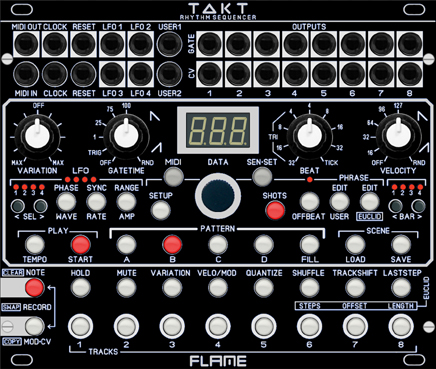 |
"TAKT" is a compact 30HP Eurorack sequencer module for playing or programming trigger/gate/velocity rhythm sequences.The sequencer has 8 tracks with trigger/gate outputs, 8 velocity/modulation CV outputs and full MIDI functionality. The CV track can also be used independently as a modulation track. Live sequencing in looper mode is possible in two ways: SHOTS for playing "note repeats" or quantized triggering via keys or sensors.
|
Four syncable LFOs with VCOs for amplitude adjustment are also provided. The LFOs are equipped with many interesting functions. This includes 26 different waveforms, phase, amplitude, speed and output voltage. This can be unipolar or bipolar (0..+5v or +/-5v) and additionally attenuated by AMP (amplitude) with built-in VCA. This means that the LFO outputs can also be adapted to modules that do not have an input attenuator. Patterns can be switched live and are each up to 4 bars long. 4 patterns plus a fill pattern are saved as a scene. 50 scenes can be permanently stored in the module. This means that 250 patterns are available in total. ... more informations: PDF - Info Flame TAKT (english) |
| manuals, updates and more here |

|
FLAME "TON"
melody looper
|
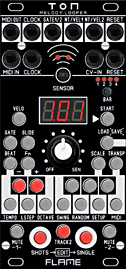 |
"TON" is a 12TE wide Eurorack live sequencer module for creating two note sequences. There are two 1V/octave outputs with GATE/NOTE/VELOCITY.
Notes can also be sent via MIDI. Both note tracks are independent of each other and can be used in different octave spreads.
In addition to the analog connection, the module has full MIDI functionality. It can be synchronized via analogue clock or via MIDI.
|
A 1-octave mini-keyboard allows transposing on the fly and setting a scale. Since the module has a CV input, it can also be used as a quantizer or arpeggiator. All settings of the current pattern are simply saved together in a patch. 128 memory locations are available. The patches can also be selected MIDI program change and can be saved and reloaded on the fly. ... more informations: PDF - Info Flame TON (english) |
|
manuals, updates and more here |

|
FLAME "BLACK FILTERBANK"
Analog Filterbank Sequencer
|
|
manuals, updates and more here |
|
FLAME "FM KOSMOS"
Quad polyphonic FM synthesizer
|
|
manuals, updates and more here |

|
FLAME "uMM"
MIDI TRS-B Merger/Thru
|
|
manuals, updates and more here |

|
FLAME "AIRLECTRON"
Distance CV recorder
|
|
manuals, updates and more here |

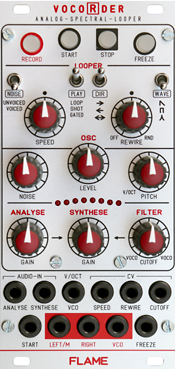 |
FLAME "VOCORDER" ANALOG-SPECTRAL-LOOPER The Flame "Vocorder" module is a compact combination of an analog vocoder and a digital CV recorder (looper). The centerpiece is an 8-channel analog vocoder with a total of 16 analog bandpass filters for analysis and synthesis. The analog generated analysis envelope CVs are digitized and output via the DA converter to the analog VCAs of the synthesis channels. The envelope CVs of the analysis channels can be recorded digitally and played back in the loop. You can manipulate the playback in different ways: swap filter channels on the fly (Rewire), change speed and playback direction etc. The module can also be a "classic normal vocoder"(direct vocoding).For the synthesis there is an internal VCO with 3 waves and white noise. External sources such as chord sounds, guitar sounds or drums can also be used via the synthesis audio input. The recording can be up to 3 minutes long and is retained in the battery-backed memory even after switching off. sound examples and more informations, manuals, downloads here |

 |
FLAME "+MIRROR" DUAL UNIPOLARINVERTER The module is an inverter for exclusively positive voltages. It inverts an applied positive voltage so that the maximum value becomes zero and zero becomes the maximum value. The input voltage is therefore not inverted into the negative voltage range (mirror axis 0v), but reflects a positive voltage around an adjustable axis within a fixed positive voltage range from 0v. There are 10 ranges, adjustable in 1V steps. The mirror axis is always on half of the set range. Negative voltages cannot be inverted with this module. Applied negative voltages are limited to approximately zero volts. The module has two identical function groups. Applications are, for example, the inversion within positive voltage ranges, GATE inversions (0/+5v to +5v/0v), or opposing melody lines (in connection with a connected quantizer). more informations, manuals, downloads here |

 |
FLAME " MCLK" MIDI-ANALOG-CLOCK-DIVIDER The " MCLK Divider" module can either work as a MIDI clock divider or as an analog clock divider. The divider outputs are assigned differently in both operating modes. After receiving a MIDI start command, the module works as a MIDI clock divider. There are fixed dividers on 11 outputs. Via the divider output KEYS, triggers can be triggered and mixed via MIDI notes. The keyboard zone extends over three octaves. With the help of the LEARN key, the receive MIDI channel and the lowest note of this 3-octave range can be defined. When stopped (i.e. after receiving a MIDI stop command or after switching on), the module works as an analog clock divider and divides the analog clock present at the CLOCK input. The 12 analog divider outputs can be reprogrammed via SYSEX. Ready-made SYSEX files are already available (e.g. for even / odd dividers, Fibonacci series, offbeats, etc.). The RESET input resets the analog counters or serves to deactivate the analog divider. more informations, manuals, downloads here |

 |
FLAME " 16MCC" MIDI control change to 16 CV The " 16MCC" module is a compact MIDI interface, which converts received MIDI control change commands on 16 outputs into CV voltages between 0 and + 5V. The resolution of the data bytes is 7bit. The outputs each have a passive lowpass filter, which smoothes the output voltages. Each of the outputs can be assigned a separate control change number between 0 and 127 on its own MIDI channel. The module is programmable via the LEARN function with a MIDI keyboard and MIDI controllers, or via SYSEX commands. Some SYSEX files with default settings already exist. The module has two MIDI sockets (mini jacks in TRS-B standard) INPUT and THRU. The data received at MIDI-IN is forwarded via MIDI-THRU. Additional MIDI modules can then be connected there. more informations, manuals, downloads here |

 |
FLAME " QMCV" Quad MIDI-to-CV interface - quad MIDI interface - 4x MIDI to Gate/Note/Velocity - programmable per sysex, Learn function - Multimode, 6 different modi: ( e.g. 4x mono, 2x duophone, 4 voice polyphone, 1x tri + 1x mono ) - MIDI Clock RUN and 16th clock outputs - 2x additional CV outputs: Mod wheel and Pitchbend wheel - MIDI input and THRU (TRS MIDI B standard) - size only 5HP more informations, manuals, downloads here |

 |
FLAME " MGTV" MIDI Gate/Velocity/Divider interface - 1 octave MIDI Keyboard to Gate or Velocity outputs - additional global output Velocity-CV - additional global output GATE - one octave for MIDI clock dividers - programmable per sysex, Learn function - MIDI input and THRU (TRS MIDI B standard) - size only 5HP more informations, manuals, downloads here |

 |
FLAME " MLFO" MIDI or analog pingable 14 LFOs - 14 LFO outputs (bipolar +/-5v) - 12 preset patches - 12 user patches - syncable or free run - programmable per sysex, Learn function - MIDI input and THRU (TRS MIDI B standard) - size only 5HP more informations, manuals here ... |


 |
FLAME "AUTOMIX" 3-to-1 mixer recorder The "AUTOMIX" module is a compact three-channel mixer for audio or CV sources in the voltage range of + -5v (audio modular level). The mix level of each track can be adjusted and recorded using the track's mix pot. The recording time per track is over one minute. The playback speed is also adjustable. The recorded track is played by pressing the Play button once (one shot) or by a longer press in the loop. In addition, the 3 inputs can be separately switched to + 6db audio via the rear slide switch (for external line level sources). All three tracks have a common reset input. The track data remains permanently stored (battery-backed memory). more informations, manuals, downloads here |

 |
FLAME "CROSSMIX" dual crossfader mix recorder The "CROSSMIX" module includes two independent crossfader with two inputs on one output and is designed for audio or CV sources in the voltage range of + -5v (modular level). In addition, the 4 inputs can be separately switched to + 6db audio via the rear slide switch (for external line level sources). The two crossmix controls can be recorded. The recording time per channel is over two minutes. The playback speed is adjustable in the playback. The recorded track is played by pressing the Play button once (one shot) or by a longer press in the loop. Both crossfaders have a separate reset input and a separate CV input (+ -5V) for controlling the mix e.g. by an LFO. The track data remains permanently stored (battery-backed memory). more informations, manuals, downloads here |

 |
FLAME "PANMIX" dual panning mix recorder The FLAME "PANMIX" module includes two independent panning mixers with one input on two left / right outputs and is designed for audio or CV sources in the voltage range of +/-5v (modular level). In addition, the 2 inputs can be separately switched to + 6db audio via the rear slide switch (for external audio line level sources). The movements of the two mix controls can be recorded. The recording time per channel is over one minute. The playback speed is adjustable in the playback. The recorded track is played by pressing the Play button once (one shot) or by a longer press in the loop. Both panning channels have a separate reset input and a separate CV input (+/-5V) for controlling the mix (e.g. by an LFO). The track data remains permanently stored (battery-backed memory). In addition, there are three additional audio / CV signal inputs (one mono and stereo left + right), which are routed directly to the output and mixed together with the two PAN channels. So you can directly mix other sources and e.g. connect two or more "PANMIX" modules together. more informations, manuals, downloads here |

 |
FLAME "XPANMIX" x-fader panning mix recorder The FLAME "XPANMIX" module is a combination of an XFADER (Crossmixer) recorder and a PANNING mixer recorder. In the upper part of the module is the XFADER with two inputs on one output. In the lower part of the module is the panning mixer with one input on two outputs left / right. The inputs are designed for audio or CV sources in the voltage range of + -5v (audio modular level). In addition, the inputs can be switched separately to + 6db audio using the slide switch on the rear (for external audio line level sources). The movements of the two mix controls can be recorded. The recording time per channel is over two minutes. The playback speed is adjustable in the playback. The recorded track is played once with a short press of the play button (one shot) or with a somewhat longer press in the loop. Both mixers have a separate reset input and a separate CV input (+ -5V) for controlling the mix, for example by an LFO. The track data remains permanently saved (if the backup battery has been installed). In addition, the output of the XFader is routed to the input of the panning mixer if there is no cable in the PAN input. Both mixers are connected in series and you can also mix the XFADER in the stereo panorama. more informations, manuals, downloads here |

|
FLAME "X-4"
poly envelope vca - quad vca
|
|
manuals, updates and more here |

 |
FLAME "C3 MK2 KNOBREKORDER"
knob recorder - cv recorder
The C3 module is a three-channel module for recording and playing back movements of controllers. Those can be recorded with each channel s individual knob. The movements will be output as control voltages. The record time amounts to one minute maximal. The track can be played once only (one shot) or in loop. The speed of the play back or the output offset is controllable with the pot. Track one has an additional CV input for CV recordings. All three tracks have a common reset input. The track data remains permanently stored when a 3V battery is used to buffer the RAM. When the module is switched on, the recorded data is available again. The module can be operated unipolar or bipolar. more informations, manuals, downloads here |

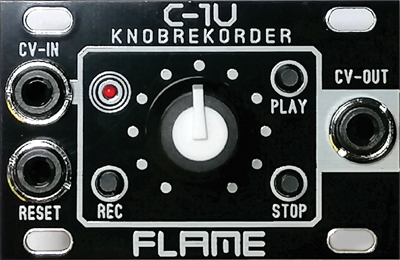 |
FLAME "C-1U KNOBREKORDER"
knob recorder - cv recorder
The C-1U module is a one-channel module for recording and playing back movements of controller. Those can be recorded with channel s knob. The movements will be output as control voltage. The record time amounts to one minute maximal. The track can be played once only (one shot) or in loop. The speed of the play back or the output offset is controllable with the pot. There are an additional CV input for CV recordings and a reset input. Track data remains permanently stored when a 3V battery is used to buffer the RAM. When the module is switched on, the recorded data is available again. The module can be operated unipolar or bipolar (set by jumper on the back). The module size is 12HP in 1U format (intellijel). more informations, manuals, downloads here |

 |
FLAME "JOYSTICK RECORDER"
2-axis Joystick - CV recorder - CV source The JOYREC is a small compact joystick module with recording function. The module can record the joystick movement to a length of about one minute. The sequence remains stored in the battery-backed RAM after switching off. When playing back the sequence, the playback speed can be manipulated. There is a FREEZE function to hold the current joystick position. Also there are an external reset input. In addition, when moving outside the center position, a GATE is set and an additional positive CV voltage (summation of X and Y) is output in dependence. A GATE / START input is used for resetting or recording in sync. The ranges of the X / Y output voltages are bipolar adjustable from approx. +/- 5v or unipolar from approx. 0 to + 10v. Both channels X and Y have a passive attenuator potentiometer, so that the voltage range can also be set lower. more informations, manuals, downloads here |

|
FLAME "CURVES"
12 band analog filter bank & sequencer
|
|
manuals, updates and more here |

|
FLAME "MEMOSLIDER"
programmable slider - step sequencer - cv source
|
|
manuals, updates and more here |

|
FLAME "DUALKEY"
key trigger - pingable AR envelope - trigger delay
|
|
manuals, updates and more here |

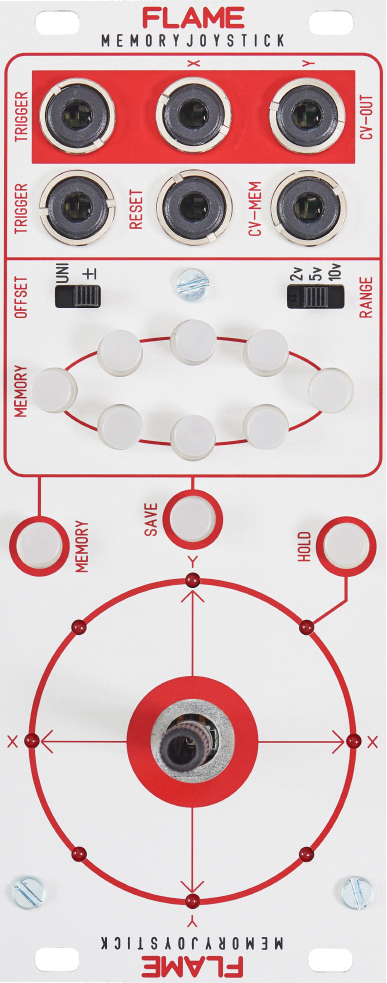 |
FLAME "MEMORY JOYSTICK"
2-axis Joystick - Stepsequencer - Dual CV source The Flame "MEMORY JOYSTICK module is a small programmable joystick, designed for small mobile euro racks. With the Memory Joystick, you can control your modular system like an old video game console. Short movements of the stick are recordable (max. ca. 3sec). Eight positions can be stored and recalled via buttons. Alternatively, it is possible to jump from one to the next value. The feel then is similar to a step sequencer. You can even vary the playback behaviour. The Memory Joystick can generate unipolar or bipolar voltages in the range of 2 V, 5 V or 10 V. more informations, manuals, downloads here |

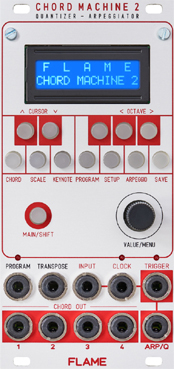 |
FLAME "CHORD MACHINE 2"
Chord generator - Arpeggiator - Keyboard Bidirectional quantizer The "Chord machine 2" euro module is a combination of chord generator, arpeggiator, bidirectional quantizer and generates maximum four part chords within a range of maximum 8 octaves. To your disposal are 42 preset chords and 16 user defined chords which can be put additionally into the first, second or third inversion. So in total there are 232 chords to your disposal. Furthermore to your disposal are 54 preset scales and 16 user defined scales, so in total there are 70 scales to your disposal. more informations, manuals, downloads here |
The module can be used for the generation of 2-note, 3-note or 4-note chords plus a fifth arpeggio voice.
The arpeggiator mode included different running directions (up, down, alternate, random) and different variations of octave ranges.
The arpeggiator channel can be used also like a quantizer.
The quantizer can run with two different scales for up and down quantizing (bidirectional).
|

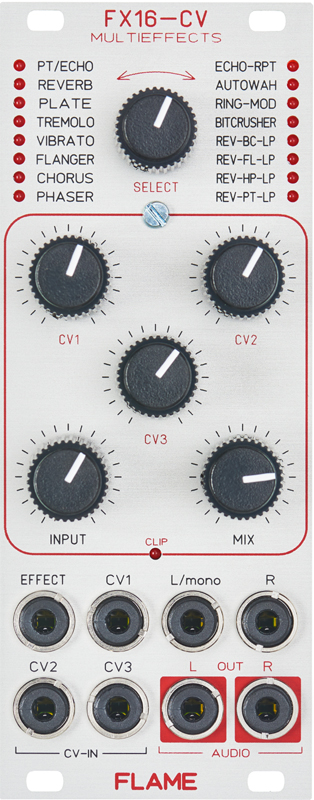 |
FLAME "FX16-CV"
Multi effect The Flame "FX16-CV module is a small low cost DSP-based (Spin semiconductors FV-1, 24bit ADC/DAC) multi effect module, designed for small mobile euro racks. 16 different multi effect programs are available. There are three knobs with additional CV inputs to change the effect parameters. Also it s possible to select the effect program with CV or pot. Audio stereo input and stereo output levels are adjusted for modular rack levels. The input can be attanuated and is protected against level peaks. The dry/wet pot can be used manually for mixing between input and effect audio signal. The outputs are buffered by an op-amp. One red LED indicates clipping. more informations, manuals, downloads here |
List of multi effect programms PITCH/ECHO (Pitchshifter-Echo) REVERB PLATE TREMOLO (Reverb-Tremolo) VIBRATO (Reverb-Envelope Vibrato) FLANGER (Reverb-Flanger) CHORUS (Reverb-Chorus) PHASER (Reverb-Phaser) ECHO-REPEAT (Stereo Ping Pong Delay) AUTO-WAH (Reverb-Envelope Lowpass) RINGMODULATOR (Reverb-Ringmodulator stereo) BITCRUSHER (Reverb-Bitcrusher-Lowpass) REV-FL-LP (Reverb-Flanger-Lowpass) REV-HP-LP (Reverb-Highpass-Lowpass) REV-PT-LP (Reverb-Pitchshifter-Lowpass) |

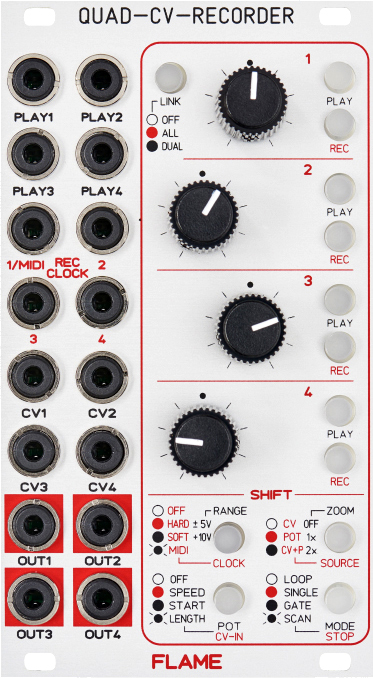 |
FLAME "QUAD CV RECORDER"
4 track CV recorder - lofi sampler The module is a four-channel CV recorder/looper that records and plays back voltage curves from very slow speeds to faster speeds by moving the controllers. You can record control voltage courses from analogue sequencers, LFOs, envelope generators, joysticks etc.. The input/output CV of each channel can range from -5v..+5v or 0..+9v. SOURCE is the CV source of the track for the recordings. This can be the CV input, the potentiometer or both. ZOOM is a two stage fine adjust function of the control ruler. Synchronization via clock or MIDI and manually "punch-in/out" recordings are possible. The output is a smoothed voltage without audible increments (algorithm with 16 bit resolution). While the Clock/MIDI Synchronisation is used, they have two different levels (HARD/SOFT) for the CV interpolation. Independent of selected sync mode, the recording time per channel is up to one hour (such us MIDI clock). Function LINK: All four channels can be used individually or in groups of two or four tracks at any one time (for multitrack or joystick recording). There are different playback modes and several functions for the playback controls. The different modes include: one-shot, triggered by a gate, a push-button or by MIDI-start/stop. The sample can be looped as well. more informations, manuals, downloads here |

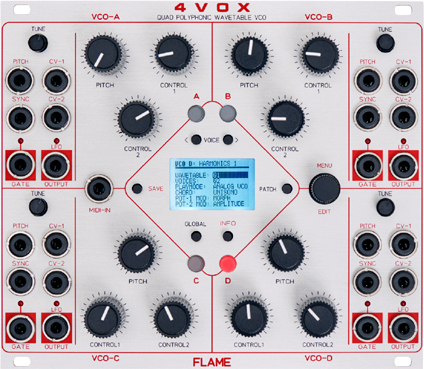 |
FLAME "4VOX"
Quad wavetable oscillator - Quad LFO - MIDI wavetable expander The 4VOX is a quad wavetable oscillator with up to four voices per VCO channel, resulting in a maximum of 16 voices at four individual outputs. Due to a MIDI input the module can be played both with CVs or/and directly via MIDI - MIDI allows for modulating some additional parameters. There are 39 memory locations for wavetables and 32 patches for all global and VCO parameters. The parameters of a wavetable can be controlled by CVs and by MIDI. For instance you can morph through a wavetable with a CV, a MIDI controller or manually with the potentiometer. The range of waves within a wavetable can be selected by minimum and maximum values individually per voice which allows for creating more complex morphs. Further controllable parameters are Detune, Semitone, Octave, Chord, Portamento, Amplitude and Amp Move (90 degrees phase shifted volume modulation of a VCO's 4 voices). Min and max values can be selected for those parameters as well. Via MIDI it's possible to control further parameters (notes, chords, pitch bend, patch selection and wavetable selection) The VCOs can be played analog (frequency by Pitch CV input), monophonic via MIDI or 4-voice polyphonic via MIDI. The VCO can be used as a voltage controllable LFO with 3 modes: LOOP, ONE SHOT and GATED. The SYNC input is used to trigger/reset the LFO. In ONE SHOT mode the LFO can be used as a trigger delay, too (SYNC = trigger in, GATE = trigger output, PITCH = delay time). Each VCO has an analog 1V/octave input including a fine tune control (+/-1 semitone) and pitch control (approx. 10 octaves), two freely assignable CV inputs, two freely assignable potentiometers, a trigger input for Sync/LFO-reset as well as a Gate and VCO/LFO output All global parameters and also the VCO's setings can be named and saved as a non-volatile patch by the user (32 patch memory locations are available). The display can show a graphic of the selected waveforms. Software/wavetable updates are easy possible via MIDI sysex dump. more informations, manuals, downloads here |

